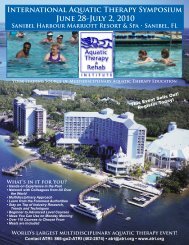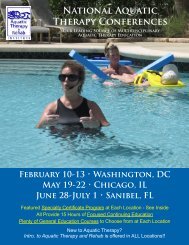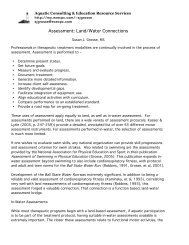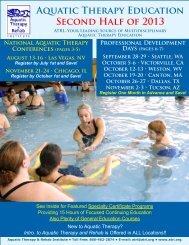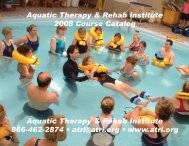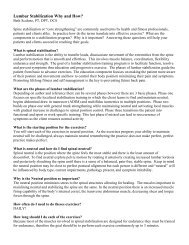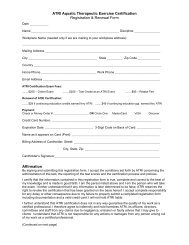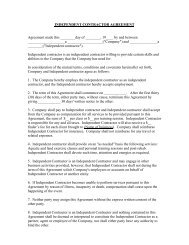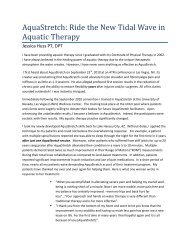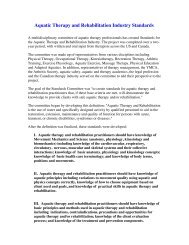Challenges with Deep Water and Lumbar Stabilization Beth Scalone ...
Challenges with Deep Water and Lumbar Stabilization Beth Scalone ...
Challenges with Deep Water and Lumbar Stabilization Beth Scalone ...
- No tags were found...
Create successful ePaper yourself
Turn your PDF publications into a flip-book with our unique Google optimized e-Paper software.
Additional equipment that can be used for adding flotation <strong>and</strong> increasing the difficultyof an exercise is the buoyancy cuff. Buoyancy cuffs come in different sizes <strong>and</strong> amountsof floatation proving an opportunity for progression. Buoyancy cuffs utilized at theankles provide a great challenge for trunk stabilization in the deep water. By increasingthe buoyancy of the lower limb the trunk <strong>and</strong> hip muscles are more active to maintain theideal vertical alignment. As the patient performs exercises in which the limb movesaway from center the rotational forces are greater. Care should used when adding thecuffs, initiating smaller movements <strong>and</strong> using shorter lever arms when introducing theequipment until the patient demonstrates adequate stabilization <strong>with</strong> the new challenge.Prone <strong>and</strong> supine recovery is especially difficult <strong>with</strong> the cuffs at the ankle. If the feet areat the surface of the water the individual should be instructed to flex the knees towardsthe chest <strong>and</strong> reach arms out in front to assist in return to vertical <strong>and</strong> avoid excessivestrain on the spine muscles.To avoid injury to the shoulder complex adequate floatation is essential. The correctvertical position at rest includes the top of the patient’s shoulder should be out of thewater. This position allows movement of the arms at the surface of the water <strong>with</strong>outexceeding 90 degrees of shoulder flexion <strong>and</strong>/ or abduction. Maintaining shoulderabduction greater than 90 degrees can cause compressive forces at the rotator cuff,placing the shoulder at risk for injury. Shoulder abduction <strong>with</strong> external rotation isrecommended <strong>with</strong> movement greater than 90 degrees.In addition to shoulder injury inadequate flotation can lead to compensatory patterns asthe patient attempts to maintain head out of water position. The most common of thesecompensations includes increased tension through h<strong>and</strong> bars <strong>and</strong> shoulder muscles,breath holding or treading water. The primary problem <strong>with</strong> poor flotation support isinterference <strong>with</strong> desired movement patterns where the patient is working harder to stayabove water <strong>and</strong> not able to concentrate on the exercise.Breathing influences the COB, depending on the amount of air held in the lungs. Cueingthe patient on a specific breathing pattern can assist their movement. Utilizing the exhalefor return to vertical <strong>and</strong> inhale to assist the body toward the surface allows the patient tomove smoothly <strong>and</strong> gain control of movement through the water <strong>with</strong>out excessivereliance on h<strong>and</strong> bars or other equipment. For example the pendulum exercise involvesthe patient to start in a T hang position <strong>with</strong> arms out abducted 90 degrees legs straightdown. The patient swings the feet to the right while reaching left arm to the left <strong>with</strong>outbending at the waist <strong>and</strong> keeping the body in the frontal plane. Having the patient inhaleas they reach to the side <strong>and</strong> exhale as they return to vertical allows the patient to get thefeel of the motion <strong>with</strong>out struggling, twisting or overworking. As strength <strong>and</strong>coordination improves change the breathing pattern to challenge the patient.Cuing is essential in deep water exercise. Proper cuing not only improves exerciseperformance but increases the patient’s perceived value of the training. If one is told tojog in the deep water for 10 minutes <strong>and</strong> does not receive feedback is that patientreceiving skilled therapy? Cues should be positive in nature, avoiding the “don’t do”



